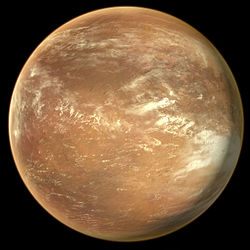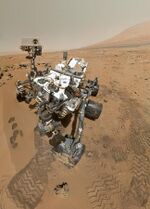Astronomy:HD 40307 e
 | |
| Discovery | |
|---|---|
| Discovered by | Mikko Tuomi et al. |
| Discovery site | La Silla Observatory, Chile |
| Discovery date | October 28, 2012 |
| radial velocity, using HARPS | |
| Orbital characteristics | |
| 0.1886 [0.1782, 0.1969] AU | |
| Eccentricity | 0.06 [0, 0.18][1] |
| Orbital period | 34.62 [34.42, 34.83][1] d |
| Semi-amplitude | 0.84 [0.53, 1.16][1] |
| Star | HD 40307 |
HD 40307 e is an extrasolar planet candidate suspected to be orbiting the star HD 40307. It is located 42 light-years away in the direction of the southern constellation Pictor. The planet was discovered by the radial velocity method, using the European Southern Observatory's HARPS apparatus[1][2][3] by a team of astronomers led by Mikko Tuomi at the University of Hertfordshire and Guillem Anglada-Escude of the University of Göttingen, Germany .[4]
The existence of the planet was disputed in 2015, as more Doppler spectroscopy data has become available.[5]
Planetary characteristics
Its minimum mass is 3.5 that of Earth - the smallest - and dynamical models suggest it cannot be much more (and so is measured close to edge-on).[1] It further gets roughly the same insolation from its star as Mercury gets from the Sun.[6] Planets like this in that system have been presumed "super-Earth".[7]
However planets b, c, and d are presumed to have migrated in from outer orbits; and planet b is predicted a sub-Neptune.[8] It is likely that this planet formed even further out. Whether it is a sub-Neptune, a super-Venus or even a super-Mercury is unknown.
References
- ↑ 1.0 1.1 1.2 1.3 1.4 Tuomi, Mikko; Anglada-Escudé, Guillem; Gerlach, Enrico; Jones, Hugh R. A.; Reiners, Ansgar; Rivera, Eugenio J.; Vogt, Steven S.; Butler, R. Paul (17 December 2012). "Habitable-zone super-Earth candidate in a six-planet system around the K2.5V star HD 40307". Astronomy & Astrophysics 549: A48. doi:10.1051/0004-6361/201220268. Bibcode: 2013A&A...549A..48T.
- ↑ Wall, Mike (November 7, 2012). "'Super-Earth' Alien Planet May Be Habitable for Life". Space.com. http://www.space.com/18393-alien-planet-super-earth-habitable-hd-40307g.html.
- ↑ Tate, Karl (November 7, 2012). "Super-Earth Planet: Potentially Habitable Alien World Explained (Infographic)". Space.com. http://www.space.com/18390-super-earth-exoplanet-habitable-zone-infographic.html.
- ↑ Murrin, Marc (November 8, 2012). "Astronomers discover a potentially habitable Super-Earth HD 40307g (Infographic)". tech-stew.com. http://www.tech-stew.com/post/2012/11/08/Astronomers-discover-a-potentially-habitable-Super-Earth-HD40307g.aspx.
- ↑ Díaz, R. F. et al. (2016). "The HARPS search for southern extra-solar planets. XXXVIII. Bayesian re-analysis of three systems. New super-Earths, unconfirmed signals, and magnetic cycles". Astronomy and Astrophysics 585: A134. doi:10.1051/0004-6361/201526729. Bibcode: 2016A&A...585A.134D. https://www.aanda.org/articles/aa/full_html/2016/01/aa26729-15/aa26729-15.html.
- ↑ Tuomi, Fig. 17
- ↑ M. Mayor; S. Udry; C. Lovis; F. Pepe; D. Queloz; W. Benz; J.-L. Bertaux; F. Bouchy et al. (2009). "The HARPS search for southern extra-solar planets. XIII. A planetary system with 3 Super-Earths (4.2, 6.9, & 9.2 Earth masses)". Astronomy and Astrophysics 493 (2): 639–644. doi:10.1051/0004-6361:200810451. Bibcode: 2009A&A...493..639M.
- ↑ Barnes, R.; Jackson, B.; Raymond, S.; West, A.; Greenberg, R. (2009). "The HD 40307 Planetary System: Super-Earths or Mini-Neptunes?". The Astrophysical Journal 695 (2): 1006–1011. doi:10.1088/0004-637X/695/2/1006. Bibcode: 2009ApJ...695.1006B.
External links
- "Super-Earth Discovered in Star's Habitable Zone". Exoplanets. 2017-05-10. http://news.discovery.com/space/habitable-zone-exoplanet-super-earth-121107.html.
Coordinates: ![]() 05h 54m 04.2409s, −60° 01′ 24.498″
05h 54m 04.2409s, −60° 01′ 24.498″
 |



